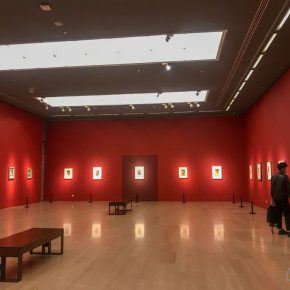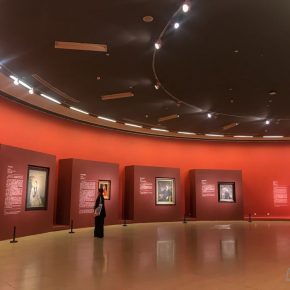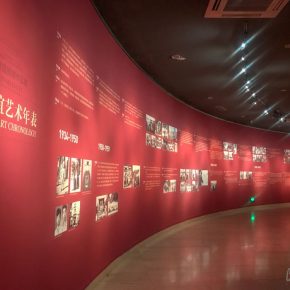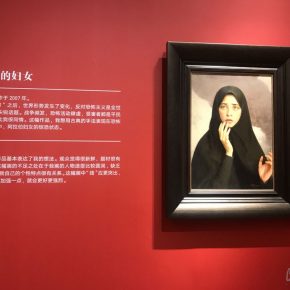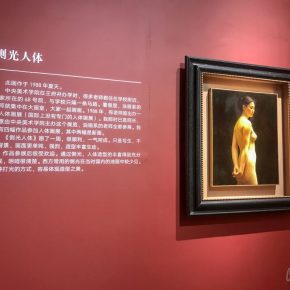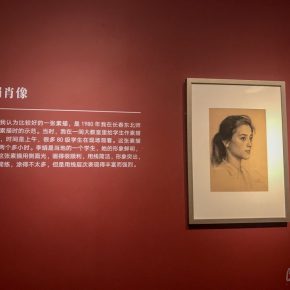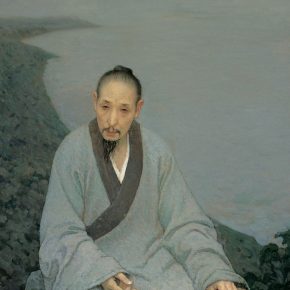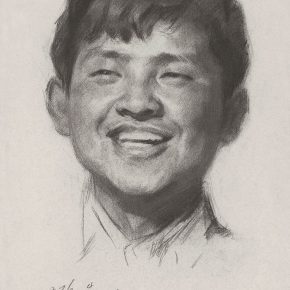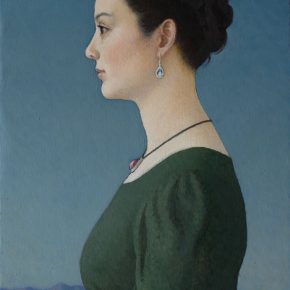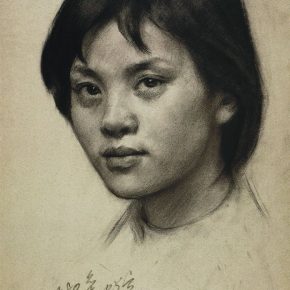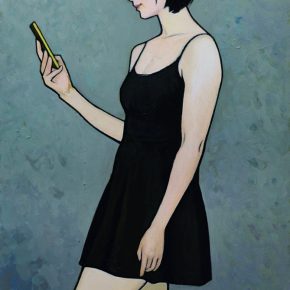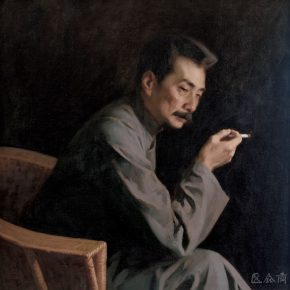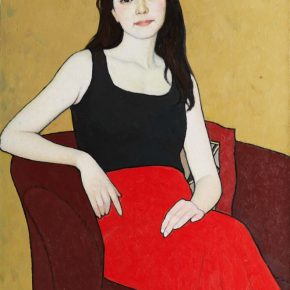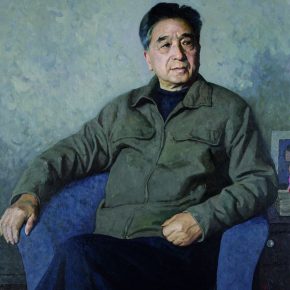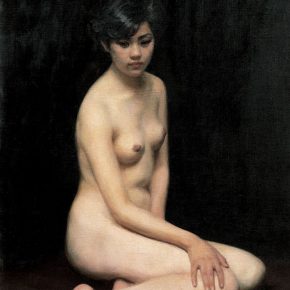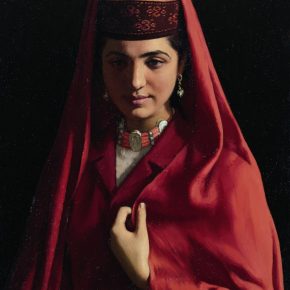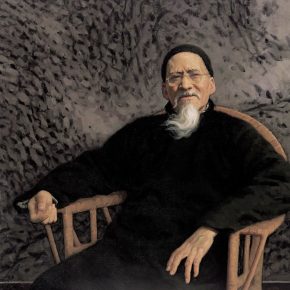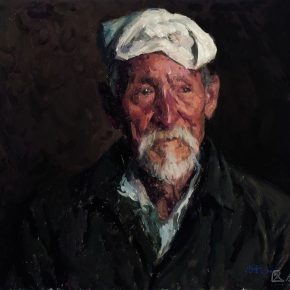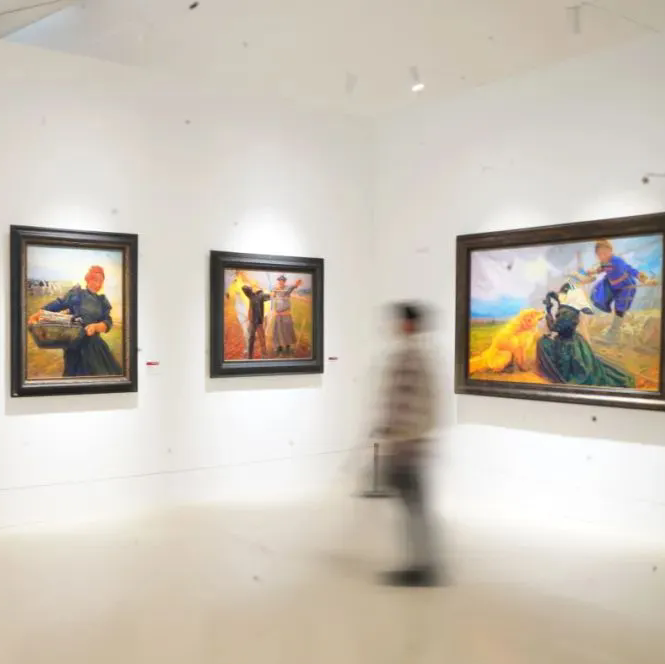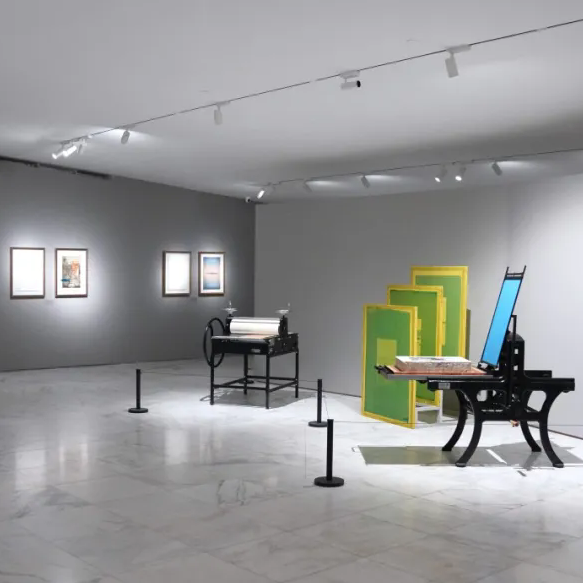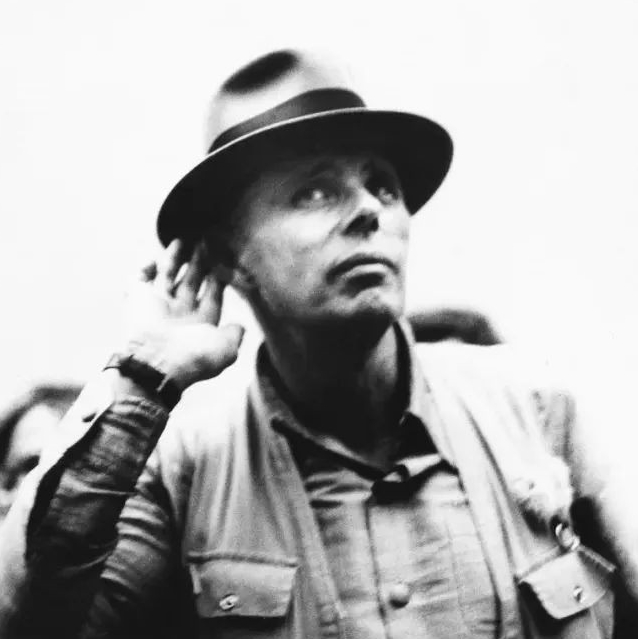“Having deep and frank feelings,
do not hesitate to express yourself,
though they may stand opposite to the current thoughts.
They may not be understood originally,
but the isolation you encounter with this will be temporary.
Shortly, friends will come to you.
What is true to one person is also true to many.
The main thing is to be moved, to love, to hope, to tremble, and to live.”
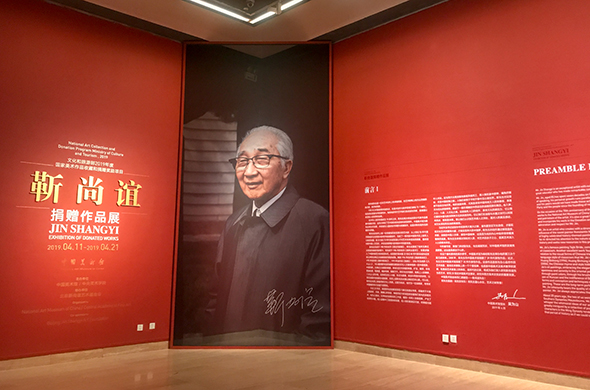
The sentences that Mr. Jin Shangyi read last year as a guest of The Reader, one of the most popular TV programs in China produced by CCTV, is written by French sculptor Auguste Rodin in Art is Emotion. The sincerity and simplicity revealed from his reading touched a lot of people, more importantly it undoubtedly sounded an alarm in the current rip-roaring art field.
This 85-year-old man is always spirited, cleared-minded and highly motivated and has received great admiration from young people. Whereas, he himself has been humbly working in the field of art creating and teaching for over 70 years.
“As a peer of the People’s Republic of China on his art life”1, Mr. Jin Shangyi started his oil painting career in 1950s under the influence of the Soviet Union painter Максимов.K.M. Ever since then, a great number of highly-praised, history-themed works were created. After Reform and Opening up, Mr. Jin turned himself to the study of Art Ontology, specializing in portrait painting. With the nourishment of classicism, his works gradually became mature. In the 1990s, he started to combine western oil painting with China’s humanistic spirits. The harmonious integration of both gave his works a special elegance and charm, which is uniquely different from the west. Until recent years, Mr. Jin was still highly productive. He keeps on challenging and breaking traditional rules, creating a series of works featuring urban figures. In a word, during his loved art career, Mr. Jin has never shown any lassitude.
“To evaluate an artist, creative thinking is a fundamental quality rather than the highest standard. Without creative thinking, one should not study art.” The candid opinion that he expressed at the interview of The Reader made him a hit on social media, which was completely beyond Mr. Jin’s expectation.
Quite a lot of people may hold that innovative thinking is a necessary and high-standard requirement for the cultivation of talent, but Mr. Jin’s opinion is that “innovation is a basic quality” that is really worthy of our reflection. As a well-known artist, Mr. Jin Shangyi took a traditional path in learning oil painting. It is a subject that has been developed for nearly six centuries in the West. While “China’s oil painting was introduced from abroad, it only has a history of 100 years, excluding 10 years’ suspension during the period of the Cultural Revolution, China’s oil painting is very young, incomparable to its 500-year development in the West. This is a fact that all of us, who are learning oil painting, should be aware of”2, Mr. Jin said. To advance oil painting forward on such a foundation and bear Chinese characteristics at the same time, the difficulty is not hard to imagine. However, Mr. Jin creatively developed his own style and firmly insisted on it. His innovation is not to abandon the tradition, but to inwardly engrave his confidence on Chinese culture. Inheriting and exploring based on the predecessors, creating and pursuing scrupulously and sincerely, Mr. Jin developed his art career through his admirable personality.
In a popular word, Jin Shangyi is an “icon”. The evergreen pine tree in China’s art garden has developed into a symbol. “The name of Jin Shangyi represents not only an artist, but also an oil painting school”3. This is not an empty praise. Critics regard Jin Shangyi and his art as a school based on two aspects: one is the influence of his oil painting path in China, the other is the joint contributions that he and the artists made under his influence to Chinese art.
Mr. Jin put it frankly that: “In the past, I was familiar with society. After the technology problems were solved, creation emerged naturally. But nowadays, I cannot understand our society, as China is developing so fast. Nevertheless, I’m still struggling to pursue this with great effort. As a painter, I am able to keep exploring and painting with no fear of age, the very reason is that I can feel the pleasure of research”4.
On April 12th, 2019, “National Art Collection and Donation Program of Ministry of Culture and Tourism, 2019 Jin Shangyi’s Exhibition of Donated Works” was inaugurated at National Art Museum of China. Displaying 87 oil paintings and sketches that Mr. Jin Shangyi created in various periods, the exhibition is co-sponsored by National Art Museum of China and the Central Academy of Fine Arts with the support of Beijing Jin Shangyi Art Foundation. 81 pieces are displayed by National Art Museum of China and the other 6 are the collections from the Art Museum of Central Academy of Fine Arts and Beijing Fine Art Academy, as well as China Art museum. The whole exhibition is divided into six sections: portraiture, landscape sketches, portrait sketches, national minority characters sketches, nude female art and new creation, covering all of Mr. Jin’s language styles in different periods and clearly presenting his transformation on creation ideologies. The exhibition provides us with an opportunity to review and understand Mr. Jin Shangyi’s art exploration and contributions.
Mr. Jin was born at Jiaozuo City, Henan Province in the late Autumn of 1934. He developed his crush on painting at a very young age and once imitated several picture-story books. Soon, his talent in painting stood out among his peers. In 1949, under the encouragement of his family, he applied to Beiping National Art Institute, as the school “had public funding and student grants”. Though this application was to save money, Jin Shangyi started his career in the art world. “In the Autumn of 1949, the 15-year-old boy stepped into the gate of Beiping Art Institute. Never had I thought that I would spend my teenage, youth, middle age, older years, and even my whole life here. Nor had I expected that I would pursue an arduous and lengthy oil painting career here”5.
Since 1950, the Institute’s pedagogy has made great changes, raising the principle that art should serve politics, workers, peasants and soldiers. Students were required to experience real life in an industrial setting, e.g. railway system or locomotive factories. Through numerous live sketches in this period, Mr. Jin came to realize the necessity of exploring art of real lives. In his memoir, he put that: “Immersing into life, feeling it and creating art based on it, is one of the most important experiences that I have gained in the four years in the Institute”6. Such feelings accompanied him all the way through his art career. Staying close to reality and extracting emotion from it is an important feature of his creations. As Mr. Fan Di’an, Chairman of China Artists Association and President of Central Academy of Fine Arts, put it at the opening salon of the Exhibition, “the exhibition displays a quantity of Mr. Jin’s early sketches and oil paintings. Though these works are small in size, a kind of freshness is vividly expressed. It derives from the observation of life and utilization of light and color. The size doesn’t matter, what’s really important is whether one can develop real emotion from life. The most precious quality of Mr. Jin and Central Academy of Fine Arts, as well as many predecessors in the art field is their closeness to reality. They are good at finding and refining beauty from life, and injecting their true emotions into works.
Recalling his graduation work as an undergraduate, Mr. Jin expressed the hard quality of an art creation. “I felt it was really difficult, and I made great effort to complete my graduation work”7. Honestly, at that time, Mr. Jin only acquired a “preliminary” understanding of fine art. While the most precious thing was that he retained his earthiness and sincerity, and injected them into every piece of his later works. Just as he read in the program, “what is true to one person, is also true to the many”. Closeness to life, honesty of heart, those are the very reasons that people are still touched by his works after so many years.
Graduating from the Fine Art Department in 1953, Jin Shangyi continued to pursue his master degree at the Institute. His breakthrough in art creation happened in 1955, when he was admitted to Максимов Oil Painting Training Class as a postgraduate. The concept of “structure” overthrew his thinking and observing method. “I had studied sketching for several years, had got my Bachelor and Master diplomas, but this time I came to truly understand the primary requirement of western sketching”. Through the study of structure, his original cognition of “outline, light and shadow, volume and space” went beyond the superficial level and advanced deeper to the essence of sketch. Curator of National Art Museum of China (NAMOC), Mr.Wu Weishan divided Mr. Jin’s artistic career into three different stages. The Realism creating concept cultivated by the Training Class can be regarded as the beginning period. In 1957, Jin Shangyi graduated from the Training Class and stayed in the school as a teacher. Since then, he has drawn a large number of portrait sketches.
“I do not conform to the trends, if others go forward, I will go backward”8. Mr. Jin’s personal style gradually became mature after 1979. Against the background that the dominant voices advocated newness and difference in China’s art field, Mr. Jin turned to devoted himself to the study of art ontological language, under the inspiration of European classicism art language style. In the early 1980s, Mr. Jin visited a large number of art museums during his family reunion period in America. He noted that in traditional European paintings, light played an important role in shaping volume and space. After coming back home, his work Tadzhikistan Bride in 1983 was born out of a plain idea: since the difference of “light” was discovered, why not experiment with new thinking and try to solve the problem of “volume” with a classical modeling method. The work is not large, but the overall picture is harmonious and pure. The three-dimensional sidelight strengthens the solidness of the volume, the woman’s red dress is particularly eye-catching but definitely not lacking in elegance, the noble hue conveys ideal emotions. The whole painting possesses rich layers and vigorous volume, expressing a particular beauty. As the analogy made by Sun Jingbo, a famous artist and professor of the Mural Painting Department, Central Academy of Fine Arts, “the painting is like cooking cornmeal porridge. The corn flour is hard, but the boiling time is really long, so the porridge turns to be thoroughly cooked”9.
Collected by NAMOC in 1984, Tadzhikistan Bride was praised by critics as the “pioneering and groundbreaking work of China’s Neoclassicism”. Apart from this, Girl in Blue Coat, Young Female Singer in 1984, and Fruits in 1985 are the masterpieces of the same series. Mr. Jin persisted in thinking based on reality. The social problems exposed after the Cultural Revolution gave the artist a deep heartache. The emotions were too strong to be calmed yet there was a limited way to make any difference. For Mr. Jin himself, art became a way to express expectation and to relieve depression. Therefore, the effective combination of his pursuit of a bright future in mentality and the exploration of the western classical style in painting techniques resulted in the above-mentioned outstanding works. His personal emotion and social reality integrated closely with his art. One of his old friends—Mr. Zhan Jianjun, who is also a distinguished professor of Central Academy of Fine Arts, commented on his exploration that: “what I admire about him is that he can make right decisions at critical moments without following the trends, to some extent, it is pioneering. For Chinese oil painting, directing it and turning it into classicism as a pioneer”10.
In Mr. Jin’s memory, Mr. Dong Xiwen was the person who influenced him the most during his study. The predecessor’s instruction was still branded on his mind. Climbing on the Muztagh Ata, the final work of the Training Class, was criticized by Mr. Dong who said that “its spirit is inconsistent”. To better it, Jin Shangyi worked hard for over 30 years. At this stage, the spirit of his paintings could be evaluated as having consistency and coherence. According to Mr. Jin the criteria for measuring a work’s maturity is its inner spirit. “imitation is not enough, even if you copy the whole oil painting pattern of the west, including its creative model, cannot be rated as mature. The West doesn’t accept such painting. Only when we acquired the western art language and their artistic expression ability, and combined it with Chinese traditional culture and spirits, can our oil painting be regarded as a grown-up”11. It is a long process for the Sinification of western oil painting. The first step is to re-examine the relation between western oil painting and China. Or, in other words, to explore the essence of Chinese culture or style, one couldn’t count on coarse, vulgar colors or stylized national symbols, whereas, working on the inward spirit, qualities like restraining, calmness, elegance, and vitality will be revealed naturally. Until now, nationalization of western oil painting is still a widely discussed issue.
Such pursuit was shown in Mr. Jin’s works in late 1980s, e.g. Qu Qiubai in Prison (1984), Sun Yat-sen (1986), Doctor (1987). Take the doctor’s depiction as an example, the image is plentiful and the figure’s expression is embedded with profound connotation, vividly displaying an intellectual’s thinking state. Through this work, Mr. Jin thought he had become aware of some differences. Except for interpreting the figure’s inner world in a much more thorough and profound way, as well as a more skillful technique, an amplified B-mode ultrasound fluorescent screen was added into the background in an indistinct yet exaggerated way to symbolically convey a modern sense. This metaphor can be seen as a highlight. Shao Dazhen, a senior professor of Central Academy of Fine Arts and a notable fine arts theorist, commented on Mr. Jin’s sketch: “on shaping the character’s image, no matter if modern or ancient times, what Jin emphasizes is not the figure’s psychological characteristics, but mainly a specific character’s particular personality, the images can be gentle and beautiful, or calm and graceful, the overall style is pure and fresh, and can be appreciated by both refined and popular tastes”12.
From 1995 when Mr. Jin Shangyi entered his third stage, combining classical realistic oil painting and Chinese traditional humanistic concepts more thoroughly. Painter Huang Binhong, Old Years of Huang Binhong, and Kuncan are the outstanding representatives. The art critic Mr. Cao Yiqiang compared the three works with the Spanish painter Velazquez’s Philip IV in Brown and Silver (around 1635), and pointed out that they utilized a similar technique, and both works achieved a complete and exquisite graphic effect. While the difference is also apparent that Mr. Jin borrowed the freehand brushwork method from traditional Chinese ink painting so that a dynamic, flowing visual effect was achieved and a quiet, solemn, simple and elegant aesthetic style was expressed, and generally, a non-western humanistic spirit was manifested. In Mr. Jin Shangyi’s own words: “I think the greatest achievement is that Chinese artists can also proficiently master the techniques of western oil painting. When I am expressing my art pursuit, I can employ both China’s profound cultural connotation and western oil painting’s consummate techniques to make my work displaying an abstract beauty which is different from the western state. I think it’s worthy of a lifelong endeavor”13.
Yu Ding, Professor and Dean of Academy of Art Management and Continuing Education, Central Academy of Fine Arts, noted at the opening salon that Mr. Jin keeps making the point that Chinese art needs to make up for Modernism. Chinese art, especially after the Reform and Opening up, bypassed the training of Modernism, jumping directly from Classicism into Postmodernism. The deformity of the art landscape resulted in a form of incompleteness and self-deception. Even today, Jin Shangyi has never for a minute stopped his exploration in art, he is still making great effort to solve the fundamental problems of art. His recent works, such as Gallery Agent (2016) and Girl Watching the Phone (2017) used black contour lines to strengthen the relation between structure shaping and space, employing some of Gauguin’s techniques faintly and adding into some elements of traditional Chinese murals. The whole picture was a return to purity. Professor Yu Ding described it as “Transformation at an old age, over-80-year-old Jin Shangyi is adhering to his art creation”14.
Inheriting the legacy of the first and second generations of Chinese art predecessors like Xu Beihong and Wu Zuoren, the third generation painters, represented by Jin Shangyi, injected new vitality into Chinese oil painting. It does not only demonstrate the spiritual glory of the old assiduous generation, but also provides continuous and profound nutrition for future Chinese art.
Nowadays, the diversity of art is obvious to us all. A certain doctrine is not the only standard, even the development of traditional painting is accompanied with controversy and disputes. The resurgence of easel art gave a group of painters new opportunities, challenges and also risks. In this ever-changing age, our pursuit in art may alter from day to day. In those anxious or confused moments, one can try to look back to the former generations’ path. At the end of the Salon, Mr Jin’s heartfelt words may provide us with some hints: “I do not intend to abide by classical forms, but to solve the problem of volume. My decades of research have been devoted to solving basic language problems, because if this problem remains unsolved, other studies will be of no significance. What should we research in the art field? We should work on improving our painting quality, regardless of differences. Style is different, it is unable to be taught, it’s born by nature”.
Text by Zhang Yizhi, translated by Pan Qiaoling and edited by Sue/CAFA ART INFO
Photo Courtesy of the Artist and the Organizer
References:
1. Fan Dian, Brochure of 2019 Jin Shangyi Exhibition of Donated Works, Foreword II.
2. Jin Shangyi’s speech at the interview of the opening salon of 2019 Jin Shangyi Exhibition of Donated Works, National Art Museum of China.
3. Cao Xingyuan, Collected Works of Chinese Oil Painters: Volume of Jin Shangyi, Foreword. April, 2005. Sichuan Art Publishing House.
4. The Author’s Words, Brochure of 2019 Jin Shangyi Exhibition of Donated Works.
5. Cao Wenhan & Jin Shangyi, Jin Shangyi: My Life in Oil Painting, P.5, Jan.2000, Jilin Art Publishing House.
6. ibid. P14.
7. ibid. P19.
8. Shi Zhongya, Exploration on Jin Shangyi’s Portrait (J), Fine Arts Education Research, 2017-11.
9. Cao Wenhan & Jin Shangyi, Jin Shangyi: My Life in Oil Painting, P97, Jan.2000, Jilin Art Publishing House.
10. Zhan Jianjun, Collected Works of Chinese Oil Painters: Volume of Jin Shangyi, Foreword. April, 2005. Sichuan Art Publishing House.
11. Cao Wenhan & Jin Shangyi, Jin Shangyi: My Life in Oil Painting, P209, Jan.2000. Jilin Art Publishing House.
12. Shao Dazhen, Collected Works of Chinese Oil Painters: Volume of Jin Shangyi, Foreword. April 2005. Sichuan Art Publishing House.
13. The Author’s Words, Brochure of 2019 Jin Shangyi Exhibition of Donated Works.
14. Yu Ding, A Free Trip: Jin Shangyi’s Oil Painting Language Exploration. 2016.


